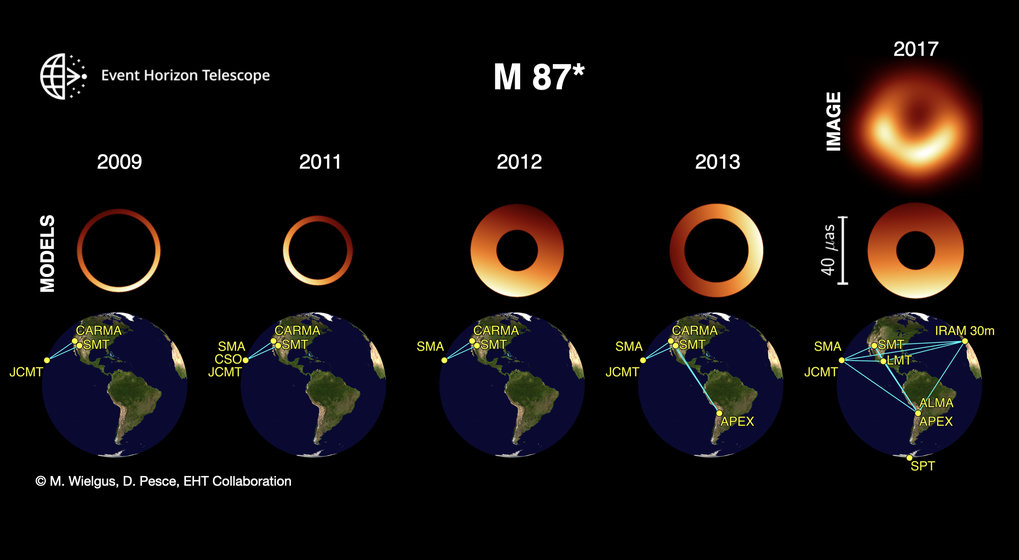Astronomers of the Event Horizon Telescope conclude from archive data how the environment of the mass monster in the galaxy M 87 has developed
In the center of the giant galaxy Messier 87 lurks a giant black hole. The image of this mass monster published last year and obtained with the Event Horizon Telescope (EHT) went around the world. Now the EHT team has analyzed archive data from 2009 to 2013, some of which are still unpublished. The researchers found that the ring-shaped shadow around the black hole is indeed always present, but changes its orientation and brightness distribution – the ring seems to be glittering. The participation of the European APEX telescope in Chile and the IRAM 30-meter telescope co-financed by the Max Planck Society on Pico Veleta in the Spanish Sierra Nevada played an important role in this result.

Snapshots of the M 87* black hole obtained through imaging / geometric modeling, and the EHT array of telescopes in 2009 – 2017. The diameter of all rings is similar, but the location of the bright side varies. The variation of the thickness of the ring is most likely not real and results from the limited number of participating observatories in earlier experiments.
“The results announced in April 2019 show an image of the shadow of a black hole, consisting of a bright ring formed by hot plasma swirling around the black hole in M 87, and a dark central part, where we expect the event horizon to be”, reminds Maciek Wielgus, astronomer at Harvard University, and lead author of the new paper.
However, those results were based only on observations performed throughout a one-week long time window in April 2017, which is far too short to see if the ring is evolving over longer time scales. Even after careful data analysis, therefore some open questions with regard to the stationarity of the ring features over time remained. For that reason, an investigation of earlier archival data was considered.
The 2009 – 2013 observations consist of far less data than the ones performed in 2017, making it hard to image M 87 without a-priori assumptions. For the available archive data, the EHT team used statistical modeling based on geometrical assumptions to look at changes in the appearance of the black hole in M 87 (M 87*) over time.
Expanding the analysis to the 2009-2017 observations, scientists have shown that M 87* adheres to theoretical expectations. The black hole’s shadow diameter has remained consistent with the prediction of Einstein’s theory of general relativity for a black hole of 6.5 billion solar masses. The morphology of an asymmetric ring persists on timescales of several years, in a consistent manner which provides additional confidence about the nature of M 87* and the origin of its shadow.
But while the diameter of the ring remained constant over time, the EHT team found that the data were hiding a surprise. Thomas Krichbaum, astronomer at the Max Planck Institute for Radio Astronomy and one of the leading authors of the publication, says: “The data analysis suggests that the orientation and fine structure of the ring varies with time. This gives a first impression on the dynamical structure of the accretion flow, which surrounds the event horizon”. He adds: “Studying this region will be crucial for a better understanding of how black holes accrete matter and launch relativistic jets.”
The gas falling onto a black hole heats up to billions of degrees, ionizes and becomes turbulent in the presence of magnetic fields. Since the flow of matter is turbulent, the ring brightness appears to glittering with time, which challenges some theoretical models of accretion.
“The monitoring of the time variable structure of M87 with the EHT is a challenge that will keep us busy over the next few years,” says Anton Zensus, Director at the Max Planck Institute for Radio Astronomy and Founding Chairman of the EHT Collaboration Board. „We are working in the analysis of the 2018 data, and preparing newer observations in 2021, with the addition of new sites such as the NOEMA Observatory in France, the most powerful radio telescope of its kind in the Northern Hemisphere and also co-financed by the Max-Plack-Gesellschaft as well as the Greenland Telescope, and Kitt Peak in Arizona,” adds Zensus. The enhanced imaging capabilities provided by this extended array will provide a more detailed view on the shadow of the black hole M 87* and on the innermost jet of the M 87 radio galaxy.
EHT / HOR






